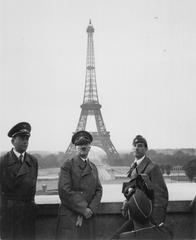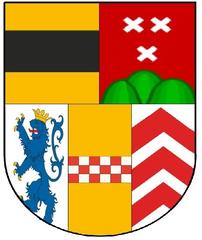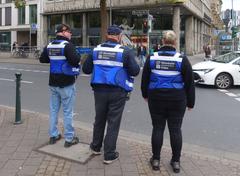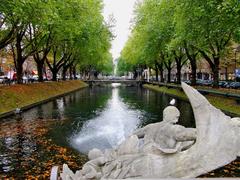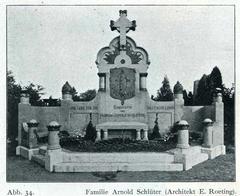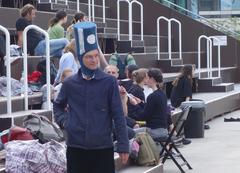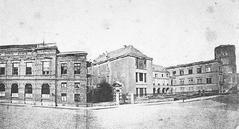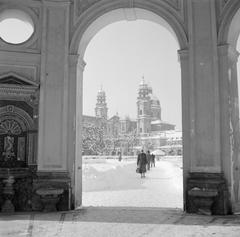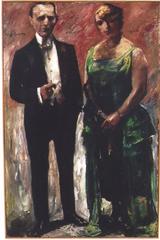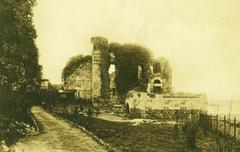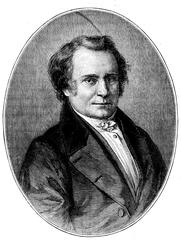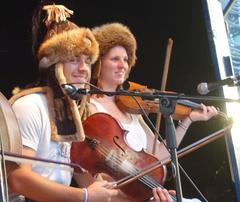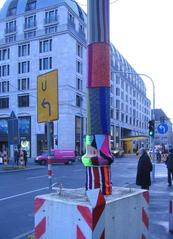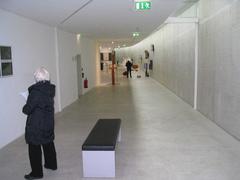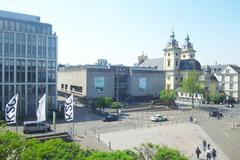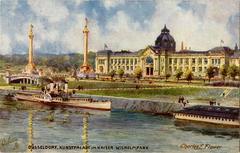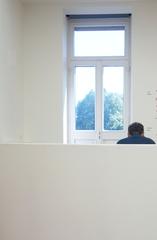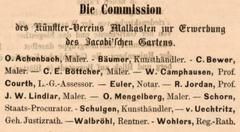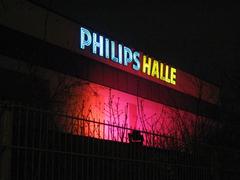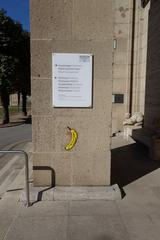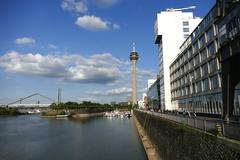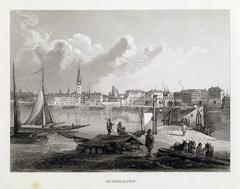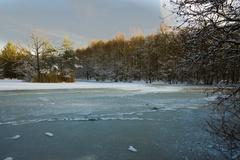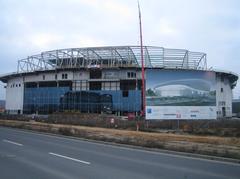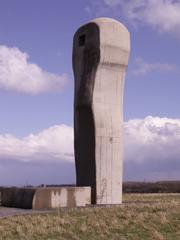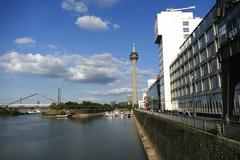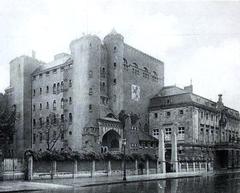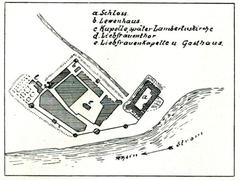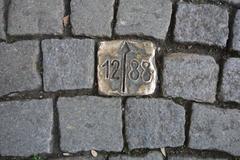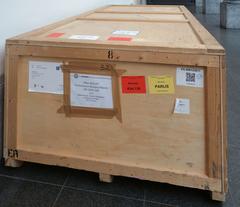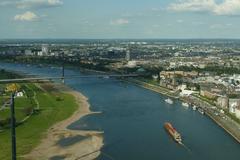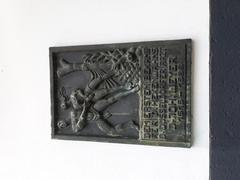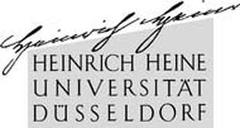
Barbarossabrunnen Düsseldorf: Visiting Hours, Tickets, and Travel Guide
Date: 03/07/2025
Introduction
In the heart of Düsseldorf, Germany, the Barbarossabrunnen stands as an enduring symbol of the city’s rich historical legacy and vibrant cultural life. Named after Emperor Frederick I “Barbarossa,” this iconic fountain not only showcases early 20th-century public art but also reflects Düsseldorf’s medieval roots and its ongoing evolution as a modern metropolis. Conceived during a period of civic pride and completed in 1925 after significant delays, the fountain has become a beloved landmark, recently restored to celebrate its centenary. Open to all and centrally located, Barbarossabrunnen offers visitors an immersive experience that bridges Düsseldorf’s storied past and dynamic present.
Whether you are a history enthusiast, a curious traveler, or a local resident, this comprehensive guide will provide everything you need to plan your visit—covering historical context, visiting hours, accessibility, nearby attractions, and practical tips for making the most of your time at this remarkable site. For further details and the latest updates, consult trusted resources such as RP Online, Visit Düsseldorf, and Germany Travel Blog.
Table of Contents
- Historical Background of Barbarossabrunnen
- Visitor Information: Plan Your Visit
- Comparative Context: Fountains of Düsseldorf
- Symbolism and Artistic Features
- Cultural Significance and Urban Memory
- Connection to Kaiserswerth and the Rhine
- Practical Tips and Accessibility
- Nearby Attractions and Experiences
- FAQ: Frequently Asked Questions
- Conclusion and Further Resources
- References
Historical Background of Barbarossabrunnen
Origins and Conception
The Barbarossabrunnen was initiated in 1912 by the Verkehrs- und Verschönerungsverein (VVV), aiming to enhance Düsseldorf’s left-bank districts. Through a public design competition, sculptor Peter Stammen’s “Schalenbrunnen” (basin fountain) was chosen, envisioned as a focal point for community gatherings and artistic enrichment (RP Online).
Construction Delays and Completion
The outbreak of World War I and subsequent economic turmoil postponed the fountain’s construction, pushing completion to 1925. These delays mirror the broader challenges faced by German cities during the interwar years, balancing recovery with aspirations for cultural development.
Artistic and Architectural Features
Barbarossabrunnen is celebrated for its graceful multi-tiered basin and whimsical putti (cherubic children) sculptures, crafted from artificial stone. These elements blend classical motifs with approachable charm, making the fountain both a historical monument and a lively public space (RP Online).
Naming and Symbolism
Dedicated to Emperor Frederick I Barbarossa, the fountain references Düsseldorf’s medieval heritage and the emperor’s historical significance, especially his ties to nearby Kaiserswerth (Wikipedia: Düsseldorf). The name fosters a sense of continuity and identity within the city.
Restoration and Evolution
The fountain has undergone several restorations, most notably in 1984 and again for its centenary in early 2025. These efforts have revitalized the monument, ensuring its preservation as a cherished landmark (RP Online).
Visitor Information: Plan Your Visit
- Location: Barbarossaplatz, Oberkassel, Düsseldorf
- Opening Hours: Open 24/7; water features typically operate April–October.
- Tickets: Free, no admission required.
- Accessibility: Wheelchair accessible with paved pathways and nearby public transport.
- How to Get There: Take tram line 4 or bus line 839 to Barbarossaplatz, or walk from the city center via Oberkassel bridge.
- Guided Tours: While no tours focus solely on the fountain, it is included in many local walking tours of Oberkassel and the Altstadt.
- Events: The VVV organizes occasional cultural events and festivals at the site.
- Photography: Best lighting during early morning or golden hour; the putti sculptures are favorite photo subjects.
Comparative Context: Fountains of Düsseldorf
Barbarossabrunnen is one of several notable fountains in Düsseldorf. In contrast to the Radschlägerbrunnen, which celebrates a local tradition of cartwheeling, Barbarossabrunnen embodies civic pride and early 20th-century public art, enriching Düsseldorf’s diverse cultural landscape (Visit Düsseldorf).
Symbolism and Artistic Features
The fountain’s design incorporates motifs that evoke medieval craftsmanship—heraldic shields, Gothic arches, and inscriptions referencing Barbarossa’s reign. The playful putti symbolize innocence and community, while the fountain’s structure points to Düsseldorf’s enduring connection to imperial history (travelwiseway.com).
Cultural Significance and Urban Memory
Barbarossabrunnen is a vital part of Düsseldorf’s identity, serving as a backdrop for local festivities, public gatherings, and educational activities. It is featured in city tours and educational materials, helping new generations connect with their city’s heritage (visitduesseldorf.de).
Connection to Kaiserswerth and the Rhine
The dedication to Barbarossa ties the fountain to Kaiserswerth, where the emperor’s castle ruins still stand. Many visitors combine a trip to the fountain with a visit to Kaiserswerth and the scenic Rhine promenade (germanytravel.blog).
Practical Tips and Accessibility
- Best Time to Visit: Late spring to early autumn (May–September) offers pleasant weather and active street life.
- Transport: The DüsseldorfCard provides unlimited public transport and discounts at attractions (germanytravel.blog).
- Amenities: Nearby cafés, restaurants, public restrooms, and tourist information offices are readily available.
- Safety: Düsseldorf is a safe city, but standard precautions are advised.
Nearby Attractions and Experiences
- Kaiserswerth Castle Ruins: Explore the remains of Barbarossa’s imperial palace along the Rhine.
- St. Suitbertus Basilica: A Romanesque church with centuries of history.
- Altstadt (Old Town): Famous for cobbled streets, Brauhäuser, and vibrant nightlife.
- Rheinuferpromenade: Picturesque riverside walkway with scenic views.
- MedienHafen: Contemporary architecture and dining hotspots (22places.de).
- Hofgarten: The city’s oldest park, ideal for relaxation (Tourist Places Guide).
FAQ: Frequently Asked Questions
Q: What are Barbarossabrunnen’s visiting hours?
A: The site is open 24/7, all year round.
Q: Is there an entry fee?
A: No, access is free.
Q: Is the fountain wheelchair accessible?
A: Yes, with paved paths and accessible facilities.
Q: Are guided tours available?
A: Yes, as part of broader city or district tours.
Q: What is the best time for photography?
A: Early morning or late afternoon for optimal light and fewer crowds.
Q: What other attractions are nearby?
A: Kaiserswerth Castle, Altstadt, Rheinuferpromenade, and more.
Conclusion and Further Resources
Barbarossabrunnen is much more than a decorative public fountain—it is a living testament to Düsseldorf’s layered history and community spirit. Its open access, central location, and cultural resonance make it a must-visit for anyone exploring the city. Whether you’re drawn by its artistic features, historical significance, or vibrant surroundings, Barbarossabrunnen promises an enriching experience.
For up-to-date information, event calendars, and guided tour options, consult the following resources:
To enhance your visit, consider using the Audiala app for audio tours, and follow Düsseldorf’s official tourism channels for news and updates.
References
- Barbarossabrunnen in Düsseldorf: History, Visitor Information, and Attractions, 2024, RP Online (RP Online)
- Barbarossabrunnen Düsseldorf: Visiting Hours, Tickets & Historical Significance, 2024, Germany Travel Blog (Germany Travel Blog)
- Visitor Experience and Practical Tips, 2024, Official Düsseldorf Tourism (Visit Düsseldorf)
- Barbarossabrunnen Visiting Hours, Tickets, and Nearby Düsseldorf Historical Sites, 2024, Visit Düsseldorf (Visit Düsseldorf)
- Wikipedia: Düsseldorf
- travelwiseway.com
- 22places.de
- Tourist Places Guide

